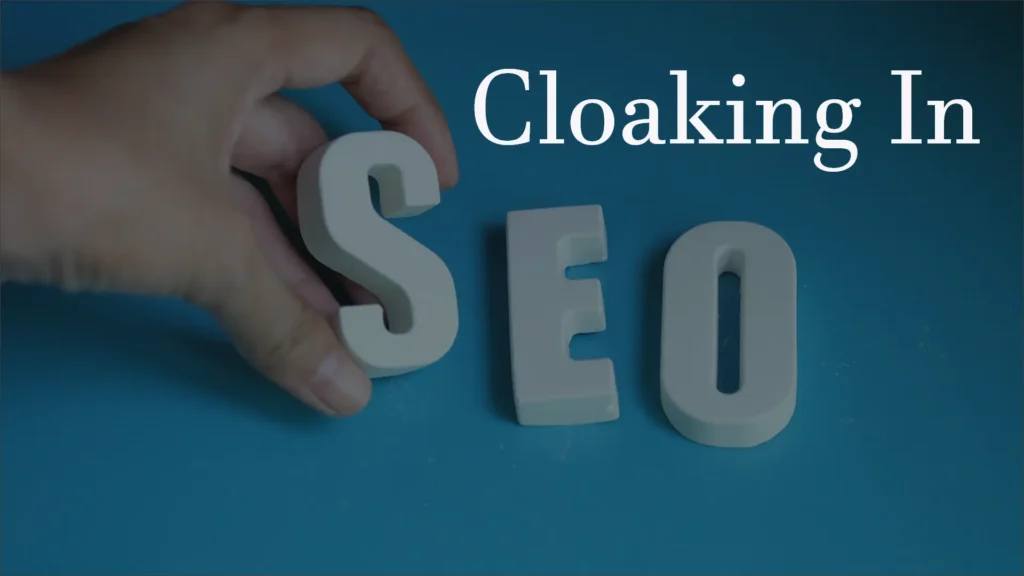
Cloaking in SEO: How It Works and Why It’s Important

Cloaking in SEO refers to the practice of presenting different content or URLs to search engines and users, to manipulate search engine rankings. Historically, cloaking has been associated with attempts to deceive search engine algorithms and achieve higher rankings than a website’s actual content deserves.
In the early days of search engines, website owners exploited vulnerabilities in algorithms, leading to the development of more sophisticated algorithms by search engines to combat such practices. Understanding cloaking is crucial for SEO practitioners because it plays a pivotal role in shaping the ethical landscape of search engine optimization. Recognizing and avoiding cloaking techniques is essential for maintaining a fair and level playing field, ensuring that search engine results accurately reflect the relevance and quality of content for users.
As search engines continue to refine their algorithms, staying informed about cloaking practices is integral to ethical SEO strategies and long-term success in online visibility.
How Cloaking Works?
Cloaking in SEO involves the strategic presentation of different content to search engines and regular users, a technique aimed at influencing search rankings. The fundamental idea is to create a discrepancy between the content perceived by search engine crawlers and the content experienced by users visiting the website.
The core concept revolves around delivering content that is specifically tailored for search engines, optimizing for higher rankings, while simultaneously presenting a different version to users for a purportedly improved user experience.
Techniques Used in Cloaking
Cloaking employs various technical methods to achieve its objectives, often leveraging factors such as IP addresses, user-agent strings, and JavaScript. These techniques are designed to identify the entity accessing the website, allowing for the dynamic serving of content based on predefined criteria.
Examples of Common Cloaking Methods :
1. IP-Based Cloaking
IP-based cloaking involves tailoring content based on the IP addresses of users, which can be indicative of their geographical location. This method aims to provide region-specific content, enhancing relevance for users from different locations.
2. User-Agent Cloaking
User-agent cloaking targets the specific user-agent strings sent by search engine bots or web browsers. By recognizing these strings, websites can serve content optimized for search engines to achieve favorable rankings, even if it diverges from what typical users would see.
3. JavaScript-Based Cloaking
JavaScript-based cloaking utilizes scripts to modify the content after the page has loaded. This dynamic manipulation allows websites to present content to search engines in a way that differs from the content visible to regular users.
How to Spot SEO Cloaking?
Detecting SEO cloaking involves a multifaceted approach. Start by comparing the content served to search engines and regular users using tools that mimic user agents. Analyze IP addresses, check for discrepancies in HTTP headers, and examine keyword usage and content variations. Manually review the website’s source code for hidden elements or keyword stuffing.
Utilize online tools designed for identifying cloaking and analyzing JavaScript for dynamic content changes. Check for redirects and engage in manual browsing using different user agents, browsers, and devices.
Pay attention to user complaints, as they may highlight inconsistencies. Regular monitoring, staying informed about SEO trends, and seeking professional advice contribute to an effective cloaking detection strategy.
Why is Cloaking Not Recommended?
Cloaking is not recommended. Here are the some reason why cloaking is not recommended :
i. Deceptive Practice
Cloaking involves presenting different content to search engines and users, which is deceptive. This undermines the trustworthiness of search engine results and goes against the principles of fair play.
ii. Violates Search Engine Guidelines
Major search engines, including Google, explicitly prohibit cloaking in their guidelines. Websites found using cloaking techniques risk severe penalties, including removal from search engine results.
iii. User Experience Concerns
Cloaking can lead to a poor user experience, as the content shown to search engines may not align with what users see. This discrepancy can confuse and frustrate visitors, potentially harming the reputation of the website.
iv. Unfair Competition
Cloaking can be used to manipulate search rankings, creating an unfair advantage for websites that engage in deceptive practices. This goes against the principles of fair competition in the online environment.
v. Penalties and Loss of Visibility
Search engines employ sophisticated algorithms to detect and penalize cloaking. Websites engaging in such practices may face significant drops in rankings, or even removal from search engine indexes, resulting in a loss of online visibility.
Ways to Avoid Penalties From Google
Here are some ways to avoid penalties from google on website :
1. Follow Search Engine Guidelines
Adhere to the guidelines provided by major search engines, such as Google and Bing. Familiarize yourself with their webmaster guidelines to avoid unintentional violations.
2. Avoid Deceptive Practices
Steer clear of intentionally misleading search engines or users. Cloaking should not be used as a tool to manipulate rankings through deceptive means.
3. Audit and Test
Conduct regular audits to ensure that your cloaking implementation remains compliant with guidelines. Test your website with various user agents to verify that the intended content is consistently delivered.
4. Be Aware of Algorithm Updates
Stay informed about search engine algorithm updates. Search engines frequently refine their algorithms, and compliance with the latest standards is crucial for sustained visibility.
5. Consult SEO Professionals
Seek advice from experienced SEO professionals or consult with experts to ensure that your cloaking implementation aligns with industry best practices and doesn’t pose risks to your website’s rankings.
Does ‘White Hat Cloaking’ Exist?
No, “White Hat Cloaking” does not exist. Cloaking, the practice of presenting different content to search engines and users, is generally considered a black hat SEO technique. Search engines discourage such deceptive practices as they undermine fair competition and user trust.
Ethical SEO practices prioritize transparency and user experience, and website owners are advised to adhere to these principles to maintain a positive online presence and avoid penalties.
Final Words - Cloaking in SEO
In conclusion, the detection of SEO cloaking requires a comprehensive and vigilant approach, incorporating various methods such as user-agent analysis, IP address monitoring, header inspection, and manual content review. Utilizing online tools, analyzing JavaScript, and checking for redirects contribute to a more robust strategy.
User complaints and staying informed about SEO trends are crucial elements in refining the detection process. Given the deceptive nature of cloaking and its potential to lead to severe penalties from search engines, website owners and SEO practitioners must prioritize ethical practices, transparency, and user-focused content.
Continuous monitoring, adaptation to evolving search engine algorithms, and collaboration with SEO professionals are essential in maintaining a trustworthy online presence and avoiding the pitfalls associated with cloaking.
FAQ's - Cloaking in SEO
Q1. What is the meaning of cloaking?
Q2. What is Cloaking in Google Ads?
Q3. Why is Cloaking not recommended by Google?
Q4. Who invented the Cloaking Technology?
Q5. Is cloaking a black hat SEO technique?
Author



